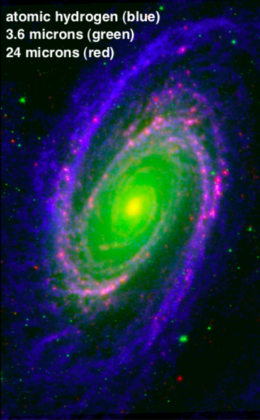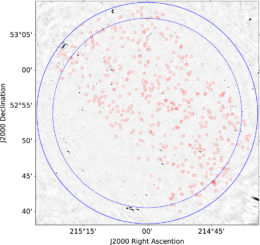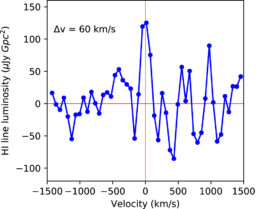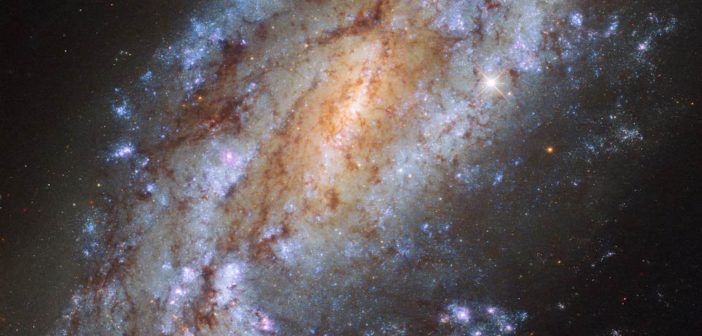How has galaxy evolution changed over our universe’s history? To understand this, we need to track galaxies’ stars and gas over time. Stars are relatively easy: they’re bright and can be observed with deep optical and infrared observations. But gas? That’s a little trickier.
Atomic Challenges

This image of local galaxy M81 reveals the extent of its atomic hydrogen gas — measured using the 21-cm emission line — in blue. [NASA Spitzer Space Telescope / NRAO VLA]
Atomic hydrogen (H I) is of particular interest: this neutral gas provides the primary fuel reservoir for star formation. But H I doesn’t have any bright emission lines, making it hard to spot. In fact, the main way to detect H I is via what’s known as the 21-centimeter line, a spectral line produced by a rare change in the energy state of the hydrogen atom. This line has such a low transition probability that you need vast amounts of hydrogen to detect it.
Since the 21-cm line is so weak, observing the neutral hydrogen from most individual galaxies beyond our local universe is out of reach until telescope technology improves. But a team of scientists led by Apurba Bera (National Centre for Radio Astrophysics, India) has used an alternative approach: stacking the observations of many distant galaxies.

The uGMRT 1.2 GHz image of the Extended Groth Strip. Red circles indicate the locations of the 445 galaxies in the authors’ sample. [Bera et al. 2019]
Amplifying a Weak Signal
Bera and collaborators used the upgraded Giant Metrewave Radio Telescope (uGMRT) in India to conduct deep radio observations of a region of the sky known as the Extended Groth Strip.
With 117 hours of observations, the team gathered detailed data for a sample of 445 blue, star-forming galaxies that lie at redshifts of 0.2 < z < 0.4. These redshifts represent galaxies from when the universe was roughly 2.5 to 4.3 billion years younger than it is now.
By stacking the spectra for these 445 galaxies, the authors were able to make a statistically significant detection of the total H I 21-cm emission — from which they could measure the average mass of H I gas in these intermediate-redshift galaxies.
How Star Factories Evolve

The stacked H I 21-cm emission spectrum of the 445 galaxies of the authors’ sample, which allows the authors to measure the average H I mass for their galaxies. [Adapted from Bera et al. 2019]
How do these numbers compare to values in both the current, local universe and the distant, much older universe? The average H I mass and depletion time are consistent with the values measured in the local universe. In contrast, higher-redshift galaxies (z ~ 1.3) have been measured to have an average H I depletion time of less than a billion years.
These results therefore suggest that the efficiency of star formation evolved drastically from our universe’s early stages up to a few billion years ago, but it has held roughly steady since then. More deep radio observations like these should help us to further explore this evolution!
Citation
“Atomic Hydrogen in Star-forming Galaxies at Intermediate Redshifts,” Apurba Bera et al 2019 ApJL 882 L7. doi:10.3847/2041-8213/ab3656

1 Comment
Pingback: Do Aluminum Abundances Foil Our Theory of Galaxy Evolution? | astrobites